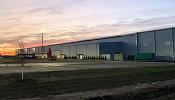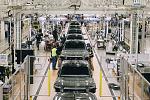- FMA
- The Fabricator
- FABTECH
- Canadian Metalworking
Categories
- Additive Manufacturing
- Aluminum Welding
- Arc Welding
- Assembly and Joining
- Automation and Robotics
- Bending and Forming
- Consumables
- Cutting and Weld Prep
- Electric Vehicles
- En Español
- Finishing
- Hydroforming
- Laser Cutting
- Laser Welding
- Machining
- Manufacturing Software
- Materials Handling
- Metals/Materials
- Oxyfuel Cutting
- Plasma Cutting
- Power Tools
- Punching and Other Holemaking
- Roll Forming
- Safety
- Sawing
- Shearing
- Shop Management
- Testing and Measuring
- Tube and Pipe Fabrication
- Tube and Pipe Production
- Waterjet Cutting
Industry Directory
Webcasts
Podcasts
FAB 40
Advertise
Subscribe
Account Login
Search
PC-based control update increases availability, simplifies maintenance of legacy sheet metal storage system
- July 12, 2019
- News Release
- Shop Management
Situation
Sheet metal fabricating machinery manufacturer Bystronic offers a portfolio of equipment including press brakes, laser cutting systems, and associated automation and software. The OEM uses its machines in its own facilities worldwide, according to Mario Duppenthaler, head of solution and software management.
The company put a sheet metal storage system into operation for a Bystronic laser cutting system at its Niederönz, Switzerland, headquarters in 1998.
“It consists of two storage towers that are 9.6 meters tall with a total of 83 bins, each measuring 3 by 1.5 meters,” Duppenthaler explained. “The maximum storage capacity is 249 tons. To remove items, a storage-and-retrieval device travels to the respective bin and transfers it to a Bystronic handling device, which removes the requested part and moves it via an automated transfer cart to the changeover table of the laser cutting machine—in this case a BySpring Fiber 3015.”
After 20 years, upgrading it made a lot of sense, said Duppenthaler.
“Unlike the actual production machines, such storage systems are usually replaced in much longer intervals. Accordingly, their control and communication technology often does not keep up with other machinery. On the other hand, the importance of such storage systems should not be underestimated. After all, they form the backbone of the entire production facility, and therefore have a considerable impact on plant availability. In addition, a retrofit provides the ability to optimize process work flows and reduce nonproductive times in order to catch up with the usually improved productivity of later-generation processing machinery.”
Resolution
The modernization of the high-bay racking system was handled by Peter Huber AG, a provider of control systems for sheet metalworking located in the Swiss town of Alpnach. A Beckhoff Solution Provider since 2010, Peter Huber provides PC-based controls for new designs of machines and robotic systems, as well as for retrofits.
General Manager Erich Schumacher believes that a smart retrofit can play a decisive role in increasing overall production efficiency.
“As equipment ages, the availability of the entire facility depends to a large extent on the availability of the individual control components. This is where the long-term availability of Beckhoff technology is essential, particularly with regard to the long-term usability of the entire facility,” Schumacher said. “In this particular warehouse, for example, PC-based control replaced 20-year-old technology whose components are no longer available and whose Eprom-based software is no longer adaptable to today’s requirements. In addition, PC-based control technology finally enabled the use of modern remote maintenance capabilities. From an operator’s perspective, both aspects—component availability and remote maintenance—are actually even more important than the potential performance improvements that can be achieved by automating a legacy system.”
For Schumacher, openness and modularity are the main arguments for deploying PC-based control technology from Beckhoff, especially in retrofit projects: “With PC-based control, you can design the control and I/O systems precisely in accordance with the individual machine requirements. For example, the modular system of I/O terminals allows you to place small control boxes exactly where you need them if you want to keep using existing cable harnesses. This means that there is no need for expensive machine rewiring. We also appreciate the consistency of the system, because all industrial PCs, from the smallest to the largest, run the same automation software. This simplifies our work considerably, particularly with retrofit projects, because the time to install these upgrades is often very limited since clients want to have their production up and running again as quickly as possible.”
At the center of the upgraded system that controls all storage work flows and the handling device is a Beckhoff CX5140 embedded PC running TwinCAT NC PTP control software, as well as TwinCAT PLC HMI software for visualizing work flows on a 12-in. CP2912 multitouch control panel. The motors in the sheet metal storage system are controlled via two AX5118 servo drives with integrated AX5801 TwinSAFE cards for motion safety functions. The I/O system comprises four EtherCAT couplers; two EK1122 EtherCAT junctions; and 50 EtherCAT terminals, including extremely compact EL1809 and EL2809 high-density digital terminals, as well as EL1904 and EL2904 TwinSAFE input and output terminals, respectively.
Having system-integrated safety technology is a particularly important aspect for Schumacher. “The safety features must not be separate from the overall control system, because having a complete data-related overview of the total system is critical if problems arise. That’s why all safety functions—such as emergency stop, safety gates, and light barriers, as well as position monitoring of the two transfer carts between the handling device and the changeover table—are implemented via TwinSAFE terminals and the TwinSAFE cards in the servo drives.”
“We plan to link the sheet storage facility more closely with the higher-level ERP system in the future,” added Duppenthaler. “For example, we want to integrate the warehouse into the so-called cockpit, a live monitoring solution that will visualize all of our production data. We are also working on a detailed systems analysis of the sheet warehouse, which is particularly important for preventive maintenance. PC-based control is open enough to easily add such capabilities at a later date.”
Beckhoff Automation LLC
www.beckhoffautomation.com
subscribe now

The Fabricator is North America's leading magazine for the metal forming and fabricating industry. The magazine delivers the news, technical articles, and case histories that enable fabricators to do their jobs more efficiently. The Fabricator has served the industry since 1970.
start your free subscription- Stay connected from anywhere

Easily access valuable industry resources now with full access to the digital edition of The Fabricator.

Easily access valuable industry resources now with full access to the digital edition of The Welder.

Easily access valuable industry resources now with full access to the digital edition of The Tube and Pipe Journal.
- Podcasting
- Podcast:
- The Fabricator Podcast
- Published:
- 05/14/2024
- Running Time:
- 62:12
Cameron Adams of Laser Precision, a contract metal fabricator in the Chicago area, joins the podcast to talk...
- Trending Articles
White House considers China tariff increases on materials

A visit to Automate 2024 reveals the future might be now

Majestic Steel Arkansas fully operational

Rivian to expand Illinois facility to manufacture midsized SUV

Why employee-owned companies make sense in manufacturing

- Industry Events
Laser Welding Certificate Course
- May 7 - August 6, 2024
- Farmington Hills, IL
World-Class Roll Forming Workshop
- June 5 - 6, 2024
- Louisville, KY
Advanced Laser Application Workshop
- June 25 - 27, 2024
- Novi, MI
Precision Press Brake Certificate Course
- July 31 - August 1, 2024
- Elgin,


























